- Home
- 21st Century Skills
- The Strategies Used by EAP and ESP Teachers in HEIs to Motivate Learners During Online Lessons
The Strategies Used by EAP and ESP Teachers in HEIs to Motivate Learners During Online Lessons
Dr. Gunjan Jain is a lecturer of Academic English at Westminster International University in Tashkent and a keynote speaker and presenter at many international conferences. Her research interests range from Second and Third Language Acquisition to Teacher Well-being. E-mail: gjain@wiut.uz
Iroda Saydazimova is a lecturer at Westminster International University in Tashkent. She teaches mainly Academic English and Research Writing modules. Her research interests include Assessment in Language Education and Academic Writing. Currently, she is involved in projects on teacher training and content development for many educational institutions and agencies. E-mail: isaydazimova@wiut.uz
Maftunakhon Artikova is a lecturer at Akfa University, and she mainly teaches Academic Writing module in the School of Education. She is mainly interested in Assessment in Language Education and Curriculum Development. She is passionate about developing materials and contemporary methods in teaching and learning. E-mail: a.maftunakhon@akfauniversity.org
Abstract
One of the fundamental concepts of being a successful teacher is to practise various motivational techniques depending on the diverse academic levels of learners. This is because a positive learning environment established by a teacher is pivotal for a learner's motivation. However, little research has been conducted to investigate the impact of motivational practices on learners' performance during online lessons in Higher Education Institutions (HEIs) across Uzbekistan. Therefore, this study aimed to investigate the motivational strategies that university teachers apply during their online classes. The research instrument used to collect primary data was a questionnaire targeting a representative 104 EAP and ESP teachers from various HEIs across several regions of Uzbekistan. The online questionnaire consisted of 15 questions to examine the teachers' opinions and observations during online teaching and the approaches they adapted to motivate students' participation and performance to achieve their learning outcomes. The results indicate that teachers in HEIs generally have a positive opinion about their students' motivation level. The teachers tend to implement several motivational strategies pertinent to providing instruction, classroom atmosphere, relationship with learners and feedback. Even though the respondents favour using online tools for assessment, their primary concern is an internet connection and only afterwards - student engagement and progress. Future research can consider including students as respondents and using an additional research tool – interviews and observations for more in-depth analysis on this topic. This may enable researchers to become involved in motivational strategies used by teachers in HEIs in Uzbekistan.
Introduction
Education is the pillar of the development and growth of every country. During the outbreak of the pandemic, educational institutions were temporarily closed affecting 94% student population in 190 countries in the world (United Nations, 2020). The closure of educational institutions brings challenges to the teachers, students, parents, and administrators. Although switching from face-to-face to remote learning has been a solution to continue education, the lack of IT skills, weak network infrastructure, and internet access were the most significant challenges to motivating the learners to attend online lessons enthusiastically.
Motivation plays an essential role in online teaching EAP and ESP. In fact, according to Dörnyei and Ushioda (2011), teachers act as key social figures who significantly affect the motivational quality of the learning process in positive or negative ways. Indeed, almost everything a teacher does in the classroom has a motivational influence on students, making teacher behaviour a powerful ‘motivational tool’ (p.109). A study conducted by Kang (2005) suggests that teachers should not rely on one single strategy but rather use as many techniques to enhance learners’ willingness to communicate, which subsumes various individual, environmental and linguistic factors. The guiding question for the researchers in this study is to explore the motivational strategies used by EAP and ESP HEIs teachers during online lessons. The present research aims to identify the strategies commonly used by the EAP and ESP HEIs teachers to motivate their learners during online classes in the context of Uzbekistan.
Literature review
The concept and importance of motivation in successful language acquisition are now widely acknowledged and applied, as can be seen from the abundance of recent significant studies (Bernaus, Wilson and Gardner, 2009; Dörnyei and Ushioda, 2011; Sali, 2013). Indeed, teachers' motivational strategies are intensely linked with students' motivation (Jones, 2019). Although many methods are developed and used to motivate language learners in different contexts and settings (cultural, online and offline), or otherwise, 'the framework of motivational teaching practice in the L2 classroom' developed by Dörnyei (2001), encompasses the strategies that can be determined as some of the most fundamental.
While some motivational strategies might be universal, others appear to be specific to certain cultures, which clearly illustrates the role culture plays in language teaching and teachers' use of motivational strategies (Cheng and Dörnyei, 2007). On the one hand, several studies conducted unanimously indicate that the top motivational teaching practices related to creating a pleasant atmosphere in the classroom, establishing a good rapport with learners, and providing clear examples while teaching (He, 2009; Rahman, 2016; Mauludin, 2021). Provision of the positive and constructive feedback and designing group tasks that promote collaboration (Cheung, 2018; Erdil-Moody and Thompson, 2020; Omar et al., 2020; Zohrabi and Farshbafan, 2022) and choosing an appropriate educational platform (Omar et al., 2020) are effective in motivating learners in the classroom.
On the other hand, in Asian settings, EFL classes seem to be more teacher-oriented (Omar et al., 2020). For example, a study conducted in Japan found that promoting learners, self-confidence and establishing a positive classroom environment were teachers' preferred strategies (Sugita and Takeuchi, 2008). However, the study from a European context (Hungary) determined that teachers' strategies such as showing personal examples, presenting tasks properly, building a good relationship with learners, making language classes interesting, supporting learner autonomy and goal-orientedness as the most preferred ones (Dörnyei and Csizér, 1998). In the same vein, 'recognizing students' efforts' was the second crucial strategy for Taiwanese teachers, yet it was not even featured among Hungarian teachers. Also, for Taiwanese English teachers, promoting learner autonomy was the least popular motivational strategy. Nevertheless, for Hungarian teachers, it was 'familiarizing learners with the target language culture' (Omar et al., 2020).
These differences exist across cultures and between teachers' and students' views on motivational strategies and their frequency (Bernaus and Gardner, 2008). Regarding students' perspectives on the attributes of effective English teachers, in addition to strategies, teachers also play a crucial role in facilitating the right language learning environment that fosters self-confidence and success (Fives and Manning, 2005). Huang's study (2006) confirmed this as student-respondents were motivated when their teachers provided modelling and feedback. Students also highly rated their teacher's enthusiasm demonstrated by their behaviour (Cheng and Dörnyei, 2007). Another critical characteristic of an effective language teacher, according to Tagaki (2005), is the teacher's ability to select a task that is appropriate for a learner's ability and is designed to promote success and communication skills. One crucial attribute to avoid for teachers was the 'social comparison of students and their achievements. Apparently, it is ineffective and detrimental as it makes learners feel anxious and passive while learning (Deniz, 2010).
Although teaching EFL has many challenges, teaching it online presents a whole new set of difficulties. Guilloteaux and Dörnyei (2008) found that the motivational practice of a teacher is connected to high levels of the learners' motivated learning behaviour and motivational state. Even if more teachers and learners had access to communication tools after the 90s, the lack of proper competencies, for both teachers and learners, in using online tools for interactive learning remains one of the hurdles (Lamy and Hampel, 2007). More specifically, the absence of non-verbal clues such as body language, eye contact, and facial expressions, reduced learners' motivation and participation. Besides, communicating online in the target language was generally more difficult for students to embrace than in traditional classroom settings. On a positive note, some online tools, including text and voice chats, games, pair-work provided teachers with an opportunity to overcome some challenges and enhance their willingness to communicate during online lessons (Zohrabi and Farshbafan, 2022). Other barriers to effective EFL/ ESL classes online include some household difficulties for teachers, particularly if they have young children to care for, students' attendance, and providing learners with timely feedback on submitted assignments (Iswati, 2021).
Collectively, these studies outline a critical role of motivation and teachers' strategies to promote it in the language classroom. To date, many studies have been conducted in different parts of the world. However, there has been very little research directly addressing this issue in the Uzbekistan context, particularly motivational strategies used in online teaching. Accordingly, in the current study, we will employ a quantitative approach and examine the opinions, experiences, and suggestions of university teachers from Uzbekistan. Our research question is as follows:
What strategies are used by EAP and ESP teachers in HEIs to motivate learners during online lessons?
Methodology
This study attempted to provide a description of the motivational strategies used by English teachers along with their perceptions of the importance and frequency of these strategies as well as challenges they faced while conducting the classes online.
The respondent body comprised 104 EAP and ESP teachers (92 females and 12 males) from 37 state and international HEIs across nine regions of Uzbekistan (Tashkent, Andijan, Fergana, Namangan, Samarkand, Khorezm, Surkhandarya, Kashkadarya and Sirdarya). Their teaching experience ranges from three to over 20 years; regarding their educational background, their degrees varied from Master’s (98), PhD (6) and Bachelor’s (5) degrees.
The research tool was an online questionnaire. The questions varied from multiple-choice, short-answer, and Likert scale to open-ended questions. The first part consisting of 7 demographic questions was developed by the researchers; the next 8 questions were designed to elaborate on teachers’ experiences in online teaching, and 6 of them were adapted from the study by Cheng and Dörnyei (2007) – only the selected topics from their clusters were used. The main reason for the partial adaptation was because these chosen six questions were applicable to our context - online teaching.
The purposive sampling was used to select the participants since they had to be EAP and ESP currently teaching at HEIs and had to have online teaching experience. The questionnaire was disseminated among the respondents through a hyperlink leading to the questions in Google Forms. Because the study covered many regions of the country, the online format was most effective and practical. Before it was administered among the respondents, the questionnaire was piloted among 10 EAP and ESP teachers, including the researchers.
Results and discussion
This section shows the key results from the questionnaire and their interpretations and comparison with the previous findings.
As Figure 1 shows, most teachers started teaching online during the pandemic, at 84 %, while over a third continued their online classes after lockdown; 16 % claimed they still teach online. That most teachers in universities were exposed to teaching online during the Covid-19 pandemic was an anticipated finding, for representatives from all spheres, including teachers, were forced to this massive transition of performing job-related tasks online.
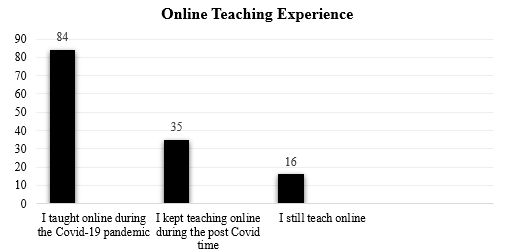
Overall, teachers reported having positive views on students’ motivation levels (Figure 2). In particular, 58% of teachers believe that students are usually on time for classes, while around 40% admit that it is the case sometimes. Similarly, more teachers said that students usually work hard on given tasks and actively participate in teacher-student interactions (41-43%), with marginally lower figures for sometimes.
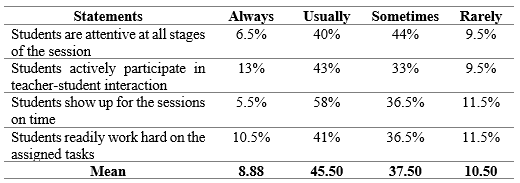
However, these findings cannot be corroborated by any previous studies because the volume of research investigating motivation in online classes in higher education is still relatively limited.
As results (Figure 3) show, teachers mainly used four motivational strategies during online lessons (60%). These strategies are (1) giving clear instructions by showing examples, (2) creating a supportive classroom so that students actively participate, (3) establishing a good relationship with students and (4) providing students with feedback. These findings are in line with the those obtained from English teachers in public universities; it revealed that top motivational teaching practices relate to creating a pleasant atmosphere, building a good rapport, and giving clear examples (Sugita and Takeuchi, 2008; He, 2009; Rahman, 2016; Mauludin, 2021).
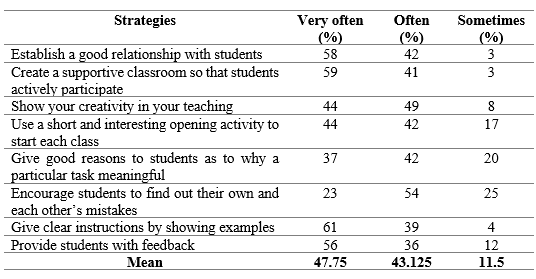
Besides, the subsequent most frequently used motivational strategies were using short opening activity to start each class (1) and showing creativity in teaching (2), both used by almost 45 % of the participants. Similarly, teachers in Omar’s study (2020) showed enthusiasm for teaching by customizing the materials to accommodate the students, which, in turn, requires creativity.
We have also found that the least frequently used method was encouraging students to find their own and each other’s mistakes, which, as we know, requires a certain degree of independence from learners. Similarly, Omar (2020) also found that strategies for promoting learner autonomy were the least essential according to the teachers at universities.
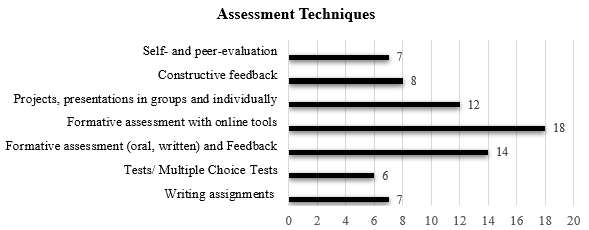
The three assessment approaches teachers found effective were formative assessment with online tools and that given orally and in written forms with feedback and finally, individual group projects provided with feedback, with 18, 15 responses each (Figure 4). These findings are consistent with the several other studies (Huang, 2006; Cheung, 2018; Omar, 2020; Erdil-Moody and Thompson, 2020); they highlight the role of promoting interaction in cooperation, giving praise, constructive and positive feedback, encouraging challenging collaborative, group work and cooperation in small groups in their investigations, while Omar (2020) also revealed that choosing the right learning platform was crucial for maintaining learners’ motivation.
Regarding the challenges (Figure 5), 75 % of the teachers reported facing internet connection problems. The following most common challenges were ensuring a learner-engagement, monitoring students’ progress and monitoring students’ attendance with 55 %, 53 %, and 49 %, respectively. While 21 % of the participants reported teaching from home as a problem, the teachers who witnessed problems regarding knowledge of using technologies and teaching from university premises constituted 16.5 % and 11.5 %, in turn. Iswati (2021) also mentions the ESP teachers in his study reported having difficulties in overseeing students’ learning progress, instability of internet connection, and students’ low discipline to attend online lessons which are similar to our findings.
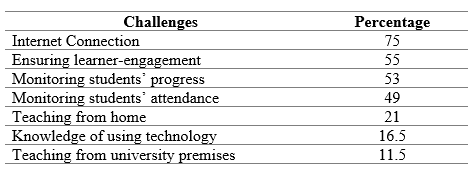
This study has some limitations. Firstly, this research employed only a questionnaire as a data collection instrument; nevertheless, for more in-depth and quality answers, interviews and observations with teachers and students would shed light on the findings. Besides, the study is based exclusively on the teachers’ perceptions and evaluations. Since teaching is a two-way interaction, students’ opinions of the motivational tools used in online classes should have been considered. This would also reduce the probability of bias in the data. We could not include this aspect because of the impracticality of reaching out to all universities in our study.
Conclusion
In the context of HIEs in Uzbekistan, university teachers of EAP and ESP use various strategies to stimulate the learners’ motivation in teaching and assessment to stimulate their participation and academic performance. The finding revealed that teachers consider their students to be motivated, and there are several strategies they choose to implement in their classes, such as providing clear instructions, creating a supportive classroom, establishing a good relationship with students, and providing students with feedback. They also find formative and alternative assessments as effective strategies to evaluate learners’ performance, although internet connection is viewed as a major obstacle in their teaching. There are limitations to this study such as using only a questionnaire and analysing only teachers’ responses. It would be better to include other methods such as interviews and observations. Besides, collecting students’ voices would also provide a more reliable examination of this question. Finally, although we have identified significant findings on motivational strategies, there is still a need to further analyse this question in the Uzbekistan context.
References
Bernaus, M., and Gardner, R. C. (2008). Teacher motivation strategies, student perceptions, student motivation, and English achievement. The Modern Language Journal, 92(3), pp.387-401.
Bernaus, M., Wilson, A., and Gardner, R. C. (2009). Teachers’ motivation, classroom strategy use, students’ motivation and second language achievement. Porta Linguarum, 12, pp.25-36.
Cheng, H. F. and Dörnyei, Z. (2007). The use of motivational strategies in language instruction: The case of EFL teaching in Taiwan. International Journal of Innovation in Language Learning and Teaching, 1(1), pp.153-174.
Cheung, Y.L., (2018). The effects of writing instructors' motivational strategies on student motivation. Australian Journal of Teacher Education (Online), 43(3), pp.55-73.
Deniz, S., (2010). Student teachers' evaluation of the motivational strategies used in foreign language teaching. Social Behavior and Personality: An International Journal, 38(9), pp.1269-1286
Dörnyei, Z. (2001). New themes and approaches in second language motivation research. Annual review of applied linguistics, 21, pp.43-59.
Dörnyei, Z. and Csizér, K. (1998). Ten commandments for motivating language learners: results of an empirical study. Language Teaching Research, 2 (3), pp.203–229.
Dornyei, Z. and Ushioda, E. (2011). Teaching and Researching Motivation. 2nd Edition, Pearson, Harlow.
Esra, M.E.Ş.E. and Sevilen, Ç., (2021). Factors influencing EFL students’ motivation in online learning: A qualitative case study. Journal of Educational Technology and Online Learning, 4(1), pp.11-22.
Erdil-Moody, Z. and Thompson, A.S., (2020). Exploring motivational strategies in higher education: Student and instructor perceptions. Eurasian Journal of Applied Linguistics, 6(3), pp.387-413
Fives, H., and Manning, D. K. (2005, August). Teachers' strategies for student engagement: Comparing research to demonstrated knowledge. In Annual Meeting of American Psychological Association, Washington DC.
Guilloteaux, M.J. and Dörnyei, Z. (2008). Motivating Language Learners: A Classroom-Oriented Investigation of the Effects of Motivational Strategies on Student Motivation. TESOL Quarterly, 42 (1), 55–77.
He, Y.N., (2009). Motivational strategies: Students’ and teachers’ perspectives. Unpublished Doctoral dissertation, Kent State University.
Huang, S. C. (2006). Reading English for academic purposes–What situational factors may motivate learners to read? System, 34(3), pp.371-383.
Iswati, L., (2021). When teaching must go on: ESP teachers’ strategies and challenges during COVID-19 Pandemic. Eralingua: Jurnal Pendidikan Bahasa Asing dan Sastra, 5(1), pp.36-52.
Jones, M. (2019). The impact of EFL teacher motivational strategies on student motivation to learn English in Costa Rica. University of Georgia.
Kang, S., (2005). Dynamic emergence of situational willingness to communicate in a second language. System 33, 277-292.
Lamy, M.-N. and Hampel, R. (2007). Online Communication in Language Learning and Teaching. London: Palgrave Macmillan UK.
Mauludin, L.A., (2021). Students’ perceptions of the most and the least motivating teaching strategies in ESP classes. Iranian Journal of Language Teaching Research, 9(1), pp.139-157.
Omar, S. et al. (2020). Motivational Strategies among English Language Teachers: An Examination in Higher Education Institutions in the Malaysian Context. Arab World English Journal, 11 (3), pp.170–183.
Quan, N.H., (2022). Attributes of effective EFL teachers in Vietnamese context as perceived by students and teachers. Indonesian Journal of Applied Linguistics, 11(3).
Rahman, E.A., (2016). The Use of Motivational Strategies by ESL Teachers in the National Defence University of Malaysia (NDUM). In 7th International Conference on University Learning and Teaching (InCULT 2014) Proceedings (pp. 235-249). Springer, Singapore.
Ranellucci, J., and Bergey, B. W. (2020). Using Motivation Design Principles to Teach Screencasting in Online Teacher Education Courses. Jl. of Technology and Teacher Education, 28(2), pp. 393-401.
Sali, P. (2013). Understanding motivations to become teachers of English: ELT trainees’ perceptions. Procedia-Social and Behavioral Sciences, 93, pp.1418-1422.
Sugita, M. and Takeuchi, O. (2010). What can teachers do to motivate their students? A classroom research on motivational strategy use in the Japanese EFL context. Innovation in language Learning and Teaching, 4(1), pp.21-35.
Tagaki, A. (2005). Motivating Japanese students in the language classroom. In Proceedings of the University of Cambridge Second Postgraduate Conference in Language Research, pp. 96-103.
UN Sustainable Development Group. (2020). Policy Brief: Education during COVID-19 and beyond. unsdg.un.org.
Zohrabi, M. and Farshbafan, L.B., 2022. Exploring EFL Teachers’ Perceptions of Strategies for Promoting Learners’ Willingness-to-Communicate in Online Classes. Applied Research on English Language, 11(1), pp.89-110.
Please check the Pilgrims f2f courses at Pilgrims website.
Please check the Pilgrims online courses at Pilgrims website.
The Strategies Used by EAP and ESP Teachers in HEIs to Motivate Learners During Online Lessons
Gunjan Jain, India;Iroda Saydazimova, Uzbekistan;Maftunakhon Artikova, UzbekistanAsynchronous Distance Learning During Pandemic Due to Covid-19: Experience of Bucheon University in Tashkent
Inna Khan, UzbekistanEnhancing Gen Z Student Collaboration Using Web 2.0 Tools in Offline, Hybrid and Fully Online Classes
Nigina Rustamova, UzbekistanInvesting in Technology in Language Education and Beyond
Mukhammadkhon Soliev, Uzbekistan;Parviz Subkhankulov, Uzbekistan